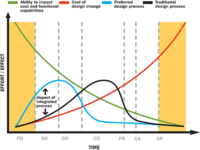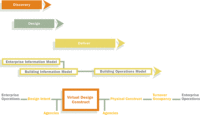The inefficiencies inherent in the process of design and construction are necessitating a shift to greater multidisciplinary collaboration and information sharing among project team members
Implications for architectural education
Many academic programs still produce students who expect they will spend their careers working as heroic, solitary designers. But integrated practice is sure to stimulate a rethinking of that notion. Pedagogy must focus on teaching not only how to design and detail, but also how to engage with and lead others, and how to collaborate with the professionals they are likely to work with later. Renee Cheng, AIA, associate professor and head of the School of Architecture at the University of Minnesota, says, “While design remains central, critically important for studio and other courses are the ability to work successfully in interdisciplinary creative teams, write and speak effectively on professional topics, and be skilled in the arts of negotiation and facilitation.” There are also questions of how to integrate BIM into curricula that are already packed. Cheng warns that “the careless introduction of BIM with all of its prerequisite skills could overwhelm the subtleties inherent in nurturing design thinking—displacing it from its central role in the architectural curriculum.” How can virtual modeling software, then, be thoughtfully integrated into a curriculum without taking precious time away from learning basic design? Cheng describes a multivalent approach at her school, which incorporates BIM in a range of formats and levels, often complementing it with drafting and hand drawing.
The AIA’s new Practice Academy initiative is intended to provide a framework for a rigorous internship by supporting innovative programs connecting academics and practitioners. The Boston Architectural College (BAC) is one of the first grant recipients; their Practice Academy is dedicated to understanding and teaching developments in IP and BIM in a unique connection with local cutting-edge firms. This pilot program could not be more timely since students will be engaged in BIM advancements in firms that are both leaders in the marketplace and initiating shifts within it.
Bruce E. Blackmer, FAIA, president-elect of the National Architectural Accrediting Board (NAAB), acknowledges that while there is no clarity at this time about the influence of IP on accreditation and education, “it is unlikely that skills in the use of particular technology tools will be expected, but those tools will be used by students to advance their demonstration of comprehensive, well-synthesized design solutions.” And more emphasis will be placed on demonstration of integrative abilities such as “collaboration and shared or teamed leadership.” In October 2008, NAAB will host its next Accreditation Review Conference; how IP should be integrated into education will be debated.
In this big-picture perspective of IP, the discussion would not be complete without keeping in sharp focus our collective goal of creating magical, delightful, and wonderful places to live, work, and play. Developing those initial design concepts is sometimes very personal and idiosyncratic. Tools such as napkins and thick markers as well as the ability to deftly move in and out of different software—and between tools and media—will always have a place in the design process.And what about preliminary design?
Geoffrey Adams, associate professor at the University of New Mexico, sheds light on this assertion by explaining that there is a fundamental difference between algorithmic computation and associative thinking, which lies at the heart of the human creative act and is the soul of design work. Adams argues, “Associative thinking, the ability to bring together disparate information from seemingly unrelated sources to create something new, is easily short-circuited when the mind is required to navigate numerous contingencies in advance of their useful deployment.” The complete model approach of BIM software is very seductive, but it should be critically evaluated on each project for its exclusive use in the initial stages of the process.
No technology fully encompasses how a designer thinks. With all the significant innovations and possibilities envisioned with BIM, there are inherent biases with any modeling tool that make it less convenient to think in other ways. Earl Mark, associate professor at the University of Virginia’s Department of Architecture, who was formerly a software engineer, explains that flexibility in describing geometry is slightly constrained because the template within the software uses fairly conventional language. However, there is capability to customize software to a specific work process. Adams adds, “The more complicated and layered a software tool is, the more likely it is to privilege certain methods of working.” Adams advises that one always be cognizant of both what the tool is doing to the design process as well as what it can do for it.
After integrated practice, what’s next?
Most people interviewed for this article agree that the advantages of integrated practice will not be fully realized until contractors come to the table as team members early on as well as consultants. But for that to happen, clients have to become confident that committing to a design-build team and guaranteed maximum price will be better than risking the delays, potential for litigation, and costs that seem inherent in the design-bid-build process. The debate has been going on for decades.
In our current practice environment, it is just not sufficient to execute projects on time and within budget while maintaining the status quo. It behooves all of us as architects to apply as much design thinking to shape a new integrated model of practice as we do to creating buildings. It is the thoughtful assimilation of this IP model in support of design excellence and a true service ethic that will define the best in professional practice. Paraphrasing William Caudill, the IP team can be a genius.




Post a comment to this article
Report Abusive Comment